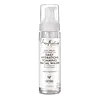What's inside
What's inside
 Key Ingredients
Key Ingredients

 Benefits
Benefits

 Concerns
Concerns

 Ingredients Side-by-side
Ingredients Side-by-side

Water
Skin ConditioningCyclopentasiloxane
EmollientCocos Nucifera Oil
MaskingPolyquaternium-47
Skin ConditioningHoney
HumectantCocos Nucifera Fruit Extract
EmollientRicinus Communis Seed Oil
MaskingVitis Vinifera Seed Oil
EmollientOlea Europaea Fruit Oil
MaskingDimethicone
EmollientPrunus Amygdalus Dulcis Oil
Skin ConditioningPhenyl Trimethicone
Skin ConditioningPersea Gratissima Oil
Skin ConditioningTocopherol
AntioxidantHelianthus Annuus Seed Oil
EmollientPEG-12 Dimethicone
Skin ConditioningSodium Chloride
MaskingPolyquaternium-37
Propylene Glycol Dicaprylate/Dicaprate
EmollientPPG-1 Trideceth-6
Skin ConditioningPhenoxyethanol
PreservativeEthylhexylglycerin
Skin ConditioningPolysorbate 20
EmulsifyingCetrimonium Chloride
AntimicrobialAmodimethicone
Trideceth-12
EmulsifyingParfum
MaskingCitral
PerfumingCitronellol
PerfumingGeraniol
PerfumingLimonene
PerfumingWater, Cyclopentasiloxane, Cocos Nucifera Oil, Polyquaternium-47, Honey, Cocos Nucifera Fruit Extract, Ricinus Communis Seed Oil, Vitis Vinifera Seed Oil, Olea Europaea Fruit Oil, Dimethicone, Prunus Amygdalus Dulcis Oil, Phenyl Trimethicone, Persea Gratissima Oil, Tocopherol, Helianthus Annuus Seed Oil, PEG-12 Dimethicone, Sodium Chloride, Polyquaternium-37, Propylene Glycol Dicaprylate/Dicaprate, PPG-1 Trideceth-6, Phenoxyethanol, Ethylhexylglycerin, Polysorbate 20, Cetrimonium Chloride, Amodimethicone, Trideceth-12, Parfum, Citral, Citronellol, Geraniol, Limonene
Water
Skin ConditioningDecyl Glucoside
CleansingCocamidopropyl Betaine
CleansingGlycerin
HumectantDicaprylyl Ether
EmollientPanthenol
Skin ConditioningSodium PCA
HumectantAllantoin
Skin ConditioningButyrospermum Parkii Butter
Skin ConditioningCocos Nucifera Oil
MaskingAcacia Senegal Gum Extract
Nelumbo Nucifera Extract
Skin ConditioningTocopherol
AntioxidantGlyceryl Oleate
EmollientTapioca Starch
Maltodextrin
AbsorbentGuar Hydroxypropyltrimonium Chloride
Skin ConditioningParfum
MaskingTriethyl Citrate
MaskingCaprylyl Glycol
EmollientBenzoic Acid
MaskingWater, Decyl Glucoside, Cocamidopropyl Betaine, Glycerin, Dicaprylyl Ether, Panthenol, Sodium PCA, Allantoin, Butyrospermum Parkii Butter, Cocos Nucifera Oil, Acacia Senegal Gum Extract, Nelumbo Nucifera Extract, Tocopherol, Glyceryl Oleate, Tapioca Starch, Maltodextrin, Guar Hydroxypropyltrimonium Chloride, Parfum, Triethyl Citrate, Caprylyl Glycol, Benzoic Acid
Ingredients Explained
These ingredients are found in both products.
Ingredients higher up in an ingredient list are typically present in a larger amount.
Cocos Nucifera Oil is obtained from the kernels of the coconut fruit. In other words, this is coconut oil.
Coconut Oil is rich in fatty acids with lauric acid making up the majority of these. It also contains linoleic acid. Due to this high fatty acid content, coconut oil helps trap moisture and soften skin.
Despite being antibacterial, coconut oil may not be great for acne-prone skin. It is comedogenic and may clog pores. This ingredient may not be safe for malassezia or fungal acne.
Note: Coconut Oil should not replace your sunscreen for UV protection. Studies show it only blocks about 20% of UV.
This oil is non-volatile and has a light scent.
The term 'fragrance' is not regulated in many countries. In many cases, it is up to the brand to define this term. For instance, many brands choose to label themselves as "fragrance-free" because they are not using synthetic fragrances. However, their products may still contain ingredients such as essential oils that are considered a fragrance.
Learn more about Cocos Nucifera OilParfum is a catch-all term for an ingredient or more that is used to give a scent to products.
Also called "fragrance", this ingredient can be a blend of hundreds of chemicals or plant oils. This means every product with "fragrance" or "parfum" in the ingredients list is a different mixture.
For instance, Habanolide is a proprietary trade name for a specific aroma chemical. When used as a fragrance ingredient in cosmetics, most aroma chemicals fall under the broad labeling category of “FRAGRANCE” or “PARFUM” according to EU and US regulations.
The term 'parfum' or 'fragrance' is not regulated in many countries. In many cases, it is up to the brand to define this term.
For instance, many brands choose to label themselves as "fragrance-free" because they are not using synthetic fragrances. However, their products may still contain ingredients such as essential oils that are considered a fragrance by INCI standards.
One example is Calendula flower extract. Calendula is an essential oil that still imparts a scent or 'fragrance'.
Depending on the blend, the ingredients in the mixture can cause allergies and sensitivities on the skin. Some ingredients that are known EU allergens include linalool and citronellol.
Parfum can also be used to mask or cover an unpleasant scent.
The bottom line is: not all fragrances/parfum/ingredients are created equally. If you are worried about fragrances, we recommend taking a closer look at an ingredient. And of course, we always recommend speaking with a professional.
Learn more about ParfumTocopherol (also known as Vitamin E) is a common antioxidant used to help protect the skin from free-radicals and strengthen the skin barrier. It's also fat soluble - this means our skin is great at absorbing it.
Vitamin E also helps keep your natural skin lipids healthy. Your lipid skin barrier naturally consists of lipids, ceramides, and fatty acids. Vitamin E offers extra protection for your skin’s lipid barrier, keeping your skin healthy and nourished.
Another benefit is a bit of UV protection. Vitamin E helps reduce the damage caused by UVB rays. (It should not replace your sunscreen). Combining it with Vitamin C can decrease sunburned cells and hyperpigmentation after UV exposure.
You might have noticed Vitamin E + C often paired together. This is because it is great at stabilizing Vitamin C. Using the two together helps increase the effectiveness of both ingredients.
There are often claims that Vitamin E can reduce/prevent scarring, but these claims haven't been confirmed by scientific research.
Learn more about TocopherolWater. It's the most common cosmetic ingredient of all. You'll usually see it at the top of ingredient lists, meaning that it makes up the largest part of the product.
So why is it so popular? Water most often acts as a solvent - this means that it helps dissolve other ingredients into the formulation.
You'll also recognize water as that liquid we all need to stay alive. If you see this, drink a glass of water. Stay hydrated!
Learn more about Water